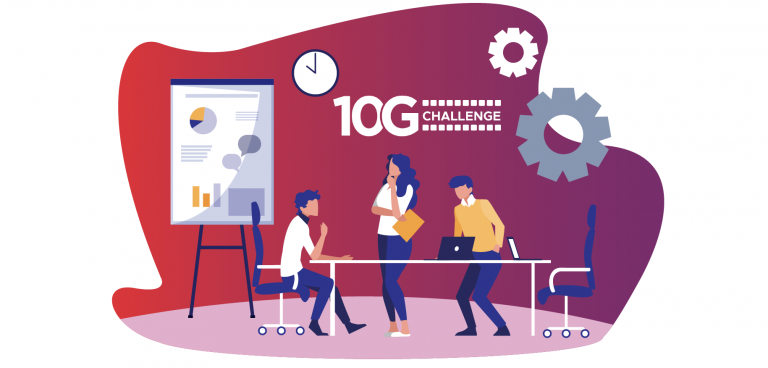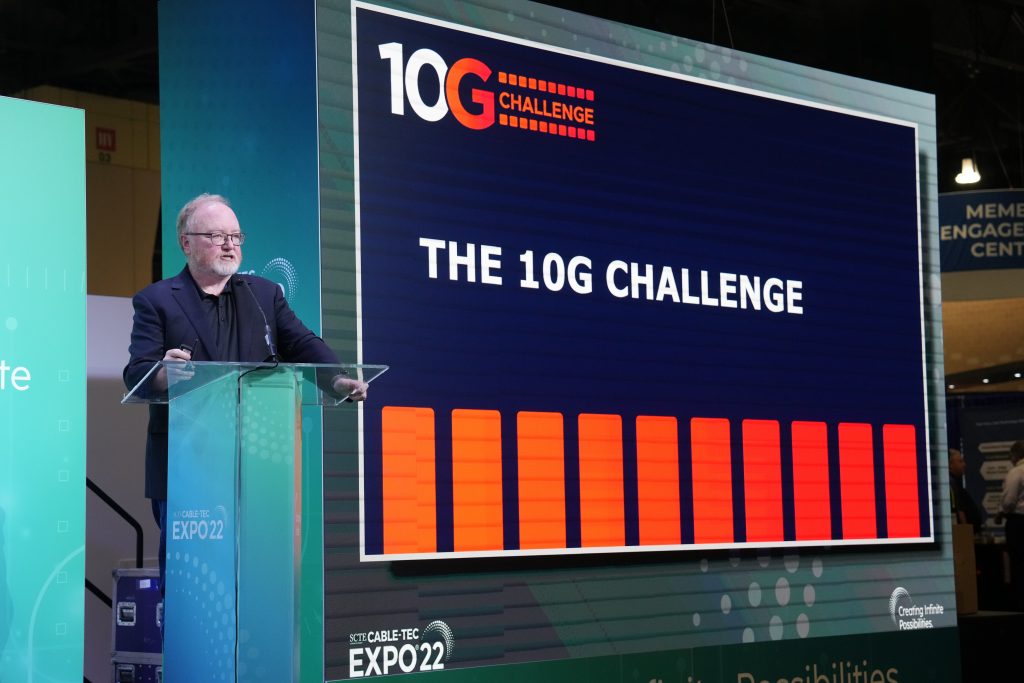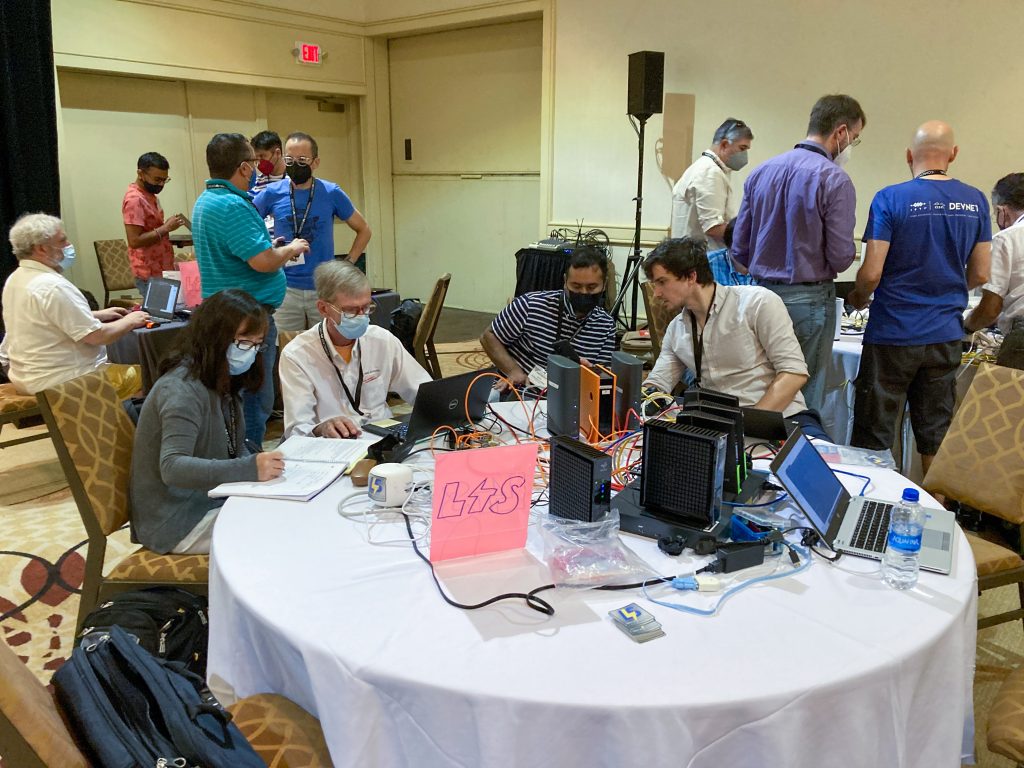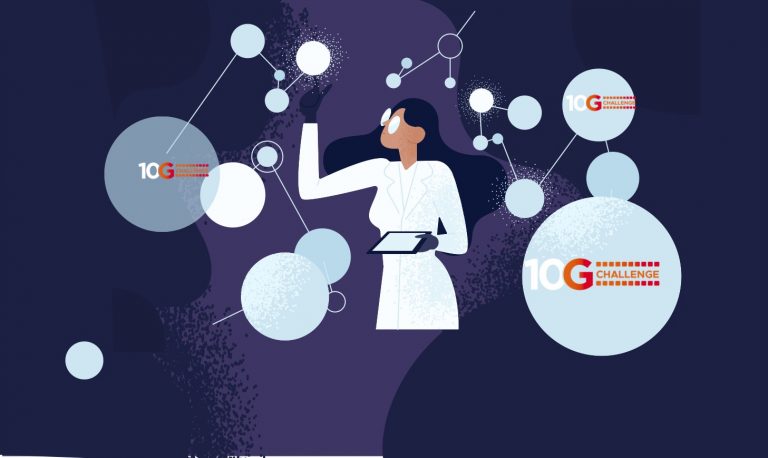10G
Unleashing the Power of the 10G Lab: Fueling Innovation and Collaboration
Key Points
- The 10G Lab supports specialized equipment for running computationally intensive workloads.
- It provides a converged environment hosting DOCSIS, PON and 5G networks.
- A multi-purpose environment, the lab supports innovation, interoperability and testing of different use cases.
- It serves as a place for collaboration among CableLabs, members and vendor partners.
CableLabs’ 10G Lab, located at our headquarters in Louisville, Colorado, drives innovation and fosters collaboration among industry partners. We welcome partners to leverage this valuable asset and co-innovate with us. In this blog post, I’ll explore the capabilities and benefits of the 10G Lab, with a special focus on its role in promoting collaboration with our vendor partners.
10G Lab Capabilities
The 10G Lab is an ideal playground for a multitude of use cases. It supports an array of hardware infrastructure, including powerful compute nodes, high-capacity storage and ample bandwidth capacity. Specialized hardware such as field-programmable gate arrays (FPGAs) and graphics processing units (GPUs) provide the computational power necessary for signal processing, 3D rendering and artificial intelligence (AI)/machine learning (ML) workloads.
The lab uses Kubernetes through the Red Hat OpenShift unified platform to build, deploy and manage applications at scale. In addition to these general compute infrastructure provisions, the 10G Lab hosts a converged environment containing DOCSIS®, PON and 5G networks, along with traffic-generation and network-simulation software to reproduce a wide variety of network topologies and conditions — a unique value proposition! Together with CableLabs’ subject matter expertise, the 10G Lab is a world-class facility with a powerful set of capabilities in a single location.
Leveraging this underlying infrastructure and networking capability, CableLabs continues to develop intent-based APIs that enable network-aware application deployment and enhanced performance as part of our Network as a Platform (NaaP) project. These APIs provide a level of insight and control of network features that ease the development of applications requiring intent-based networking. Many of the NaaP APIs are being standardized through the CAMARA project, an open-source project within the Linux Foundation to define, develop and test the APIs. Stay tuned for more details about current and future standardized API work with the NaaP project at CableLabs.
The 10G Lab also recently served as the host lab for the 5G Challenge, sponsored by the Institute for Telecommunication Sciences (ITS) — the research and engineering arm of the U.S. Department of Commerce’s National Telecommunications and Information Administration (NTIA). The goal of the 5G Challenge is to accelerate the development and widespread deployment of open and interoperable 5G networks with true plug-and-play operation.
10G Lab Benefits
At CableLabs, we firmly believe in the power of collaboration. We work with our vendor partners to develop proof of concept (POC) applications, facilitate the interoperability of network components, and enable the testing of next-generation network and service capabilities. CableLabs shares the output of the work conducted in the 10G Lab with our member operators and showcases the developments at leading telecommunications conferences and in CableLabs publications such as white papers and blogs.
Our goal is to bring cutting-edge innovations to the forefront, using the 10G Lab environment as a catalyst to bring those innovations to fruition.
Vendor Partner Success Stories
Flash Networks
Flash Networks is a company that improves subscriber quality of experience, drives radio spectral efficiency and monetizes mobile internet traffic with its vHarmony Mobile Internet Services Gateway. Initially lacking access to a DOCSIS network to test its solution, the company found a lifeline in the 10G Lab. Partnering with Flash Networks, CableLabs provided the necessary infrastructure and networking in the 10G Lab to enable the company to gather informative metrics on running its product within the DOCSIS network under various network conditions. The results that Flash Networks obtained were invaluable in presenting its offerings to potential customers in the broadband industry.
“This was Flash Networks’ first experience with CableLabs and a very positive one. The CableLabs 10G Lab environment is very flexible and allowed us to test our value in multiple real-life use cases. The CableLabs team was very professional and collaborated with us efficiently while using their vast experience to achieve great results. We truly hope that this collaboration with CableLabs is a great first step for Flash Networks as it enters the cable industry. The Flash Networks team is looking forward to further cooperation with CableLabs.” — Ofer Gottfried, CTO at Flash Networks
Casa Systems
Casa Systems designs and builds networking systems for the broadband and wireless industries. CableLabs partnered with Casa Systems to enable both the DOCSIS access network and a 5G network in the 10G Lab. The company’s virtual Converged Cable Access Platform (vCCAP), Remote PHY devices (RPDs) and 5G Core are foundational components that make up a substantial part of the backbone of the 10G Lab. With this networking capability in place, CableLabs has been able to demonstrate use cases involving converged networks and intent-based networking APIs at conferences and directly with network operators that are members of CableLabs.
“Casa Systems proudly stands at the forefront of innovation alongside CableLabs, shaping the future of networking technology. Together, we've unlocked the potential for converged networks and intent-based networking APIs, showcasing use cases that redefine connectivity at its core. We look forward to continuing our partnership to unveil a new era of possibilities for network operators.” — Colin Kincaid, CPO at Casa Systems
NVIDIA
CableLabs collaborated with NVIDIA to develop a proof of concept around GPU split rendering at the edge, utilizing the NVIDIA CloudXR platform and NVIDIA GPUs, including the NVIDIA L40 and A40 GPUs, in the 10G Lab. This unique opportunity allowed CableLabs to research what the networking requirements would be to enable virtual reality (VR) gaming using edge resources in lieu of local gaming equipment.
“Advanced computing and networking are needed to tackle today’s biggest VR innovation and collaboration challenges. Working with CableLabs enables us to build meaningful extended reality experiences and expertly demonstrate it to the CableLabs members, who are leading providers of broadband.” — Greg Jones, Director of Global Business Development for Extended Reality at NVIDIA
The 10G Lab is open to collaboration with CableLabs members and the NDA vendor community. We encourage members and vendors to partner with us to showcase innovations in the 10G Lab. You can also join the CableLabs community as an NDA vendor.
Driving Industry Progress Together
In a rapidly evolving technology landscape, our 10G Lab stands out as a beacon of innovation and collaboration. Its comprehensive hardware resources, diverse network environments and integration capabilities make it a playground for experimentation and development.
Vendor partner success stories serve as testaments to the 10G Lab's versatility. With CableLabs and its vendor partners working in harmony, the 10G Lab becomes a place where breakthroughs are shared with the industry through blogs and white papers, at conferences, and directly with leaders that operate wired and wireless networks around the world.
We look forward to a future in which the 10G Lab continues to drive industry progress and foster a spirit of shared knowledge and success.

10G
Celebrating 5 Years of 10G: Revolutionizing Connectivity and Igniting the Future
The broadband industry stands on the threshold of transforming the online experience through widespread deployment of the 10G network. With technologies capable of delivering faster speeds, lower latencies, enhanced reliability and better security in a scalable manner, 10G is already available for many home and business applications — and soon, the network will be widely available for many more.
“CableLabs, along with our members and the vendor community, made remarkable progress on the path to 10G. The near future is here,” said Phil McKinney, CableLabs President and CEO. “When we announced the promise of 10G in 2019, we set ambitious goals on our 10G roadmap — and we are pleased that our efforts have delivered transformative, next-generation technology that will support future generations for years to come.”

What Milestones Were Reached?
Over the past year, the broadband industry has seen significant progress toward faster download speeds, reduced buffering, lower latency and better security. Ultimately, these efforts will deliver more reliable user experiences to support immersive media, videoconferencing, gaming, artificial intelligence and other applications. Built upon existing hybrid fiber coax (HFC) infrastructure, such experiences will soon be widely available thanks to progress in key areas.
DOCSIS 4.0 Specifications and Events
DOCSIS® 4.0 technology makes it possible to support high reliability and security while delivering symmetrical multigigabit speeds and low latency. In 2023, CableLabs published the certification for DOCSIS 4.0 cable modems and certified the first cable modem with Low Latency DOCSIS (LLD) support. In addition, we hosted interoperability events focusing on speed, security and reliability. These events brought together suppliers and operators to share knowledge and technology advancements.
FTTP Adoption
Accelerating the adoption of fiber to the premises (FTTP) is a critical step toward harnessing the potential of the passive optical network (PON). To move the needle in this area, CableLabs spearheaded two working groups in 2023 to facilitate fiber network collaboration. One group continues to focus on optical operations and maintenance, while the other is working toward developing a DOCSIS framework specification for provisioning International Telecommunication Union (ITU)-based PON technology.
Low Latency DOCSIS
Comcast kicked off the first Low Latency DOCSIS field trials. CableLabs also certified the first cable modem with LLD support.
CPON Architecture
Alongside DOCSIS 4.0 advancements and FTTP adoption, coherent PON (CPON) developments help prepare networks for the increased demands of the future. Using the newly released CPON specification, CableLabs worked to define the high-level architecture, setting the stage for supporting increased capacity per wavelength, extended reach and higher port density.
Member 10G Network Deployments
CableLabs members also made strides toward 10G adoption in 2023, and broadband providers around the world announced their roadmaps to deployment. Many of these companies have already begun physical deployment or are working toward it, including:
Charter — As it continues its network expansion across the nation, Charter named several vendor partners to support its roadmap toward network-wide symmetrical multi-gigabit service.
Comcast — Comcast began the nation’s largest and fastest multi-gig rollouts with its Xfinity 10G network, upgrading service to 10 million homes and businesses. The company also introduced next-generation internet powered by DOCSIS 4.0 technology to the world’s first residential customers.
Cox — With recent lab tests of DOCSIS 4.0 technology, Cox has continued to reaffirm its commitment to the 10G initiative, planning a multi-billion-dollar annual infrastructure investment to build a 10G network.
Mediacom — Mediacom, a CableLabs member working to build fiber-optic infrastructure in smaller towns and cities in America, began transitioning Iowa’s leading gigabit network to 10G in 2023.
VodafoneZiggo — Liberty Global’s Dutch subsidiary became the first company in the world to conduct a DOCSIS 4.0 test on a live network.
GCI and Midco — These two companies are among CableLabs’ members on target to achieve 10G speeds by 2025.
What’s Ahead in 2024?
With the start of a new year, we’re gazing out over the horizon to a future where interoperability, low latency and reliable connections are the norm in every home and office building.
CableLabs will continue to lead the charge toward 10G realization by advancing technology innovation, fostering interoperability and supporting member deployments. As the leading innovation and R&D lab for the broadband industry, we remain committed to empowering next-generation broadband connectivity with technologies that meet or exceed the evolving needs of the industry.

10G
L4S Technology: A New Congestion-Control Solution for Latency

In a digital world where every second counts, technologies that enable smooth, efficient transmission of data are paramount to ensuring the quality of our online experiences. Reliable connectivity is a must, and the need for it grows exponentially more essential every day, particularly as more applications harness the power of 10G.
The 10G platform is a game-changing, multigigabit network made possible by DOCSIS technologies. It will deliver faster speeds, enhanced reliability, better security and lower latency. Low latency is especially critical for real-time communication applications because it helps create user experiences that are free of delay and disruption.
Many of the applications that we use every day weren’t designed with low latency in mind, and they actually cause network congestion that can disrupt our real-time communications. That’s why we need solutions that can relieve networks of this congestion by combating latency, jitter and packet loss. Low Latency, Low Loss, Scalable Throughput (L4S) technology is a part of that solution.
What Causes Network Congestion and Latency?
It’s important to understand the source of network congestion and the reason for it. Although it’s well known that latency increases when congestion increases, what’s less commonly known is why it happens. Contrary to what many people think, it’s not the result of too much traffic and too little available bandwidth.
In reality, most of the applications we use every day use congestion control. What that means is that applications are constantly adjusting their sending rates, aiming to send as fast as they can and backing off only when they detect congestion. But congestion-control mechanisms that applications use haven’t evolved significantly since the early days of the internet in the mid-1980s. Those algorithms, such as TCP Reno and CUBIC, rely on the network to provide deep packet buffers and then drop packets when the buffers overflow. The algorithm ramps up, causes delay and packet loss, backs off and ramps up again. As a result, those mechanisms can introduce latency, jitter (also known as latency variation) and packet loss — not only to themselves but also to other applications using the network at the same time.
What Is L4S?
L4S is a core component of the Low Latency DOCSIS specifications, which many other networking technologies are also adopting. It enables a new congestion-control mechanism for capacity-seeking applications wanting to optimize their sending rate, while dramatically reducing network latency, jitter and packet loss.
L4S is ideal for applications that are optimized by high data rates, consistent ultra-low latency and near-zero packet loss — including cloud gaming and virtual reality/augmented reality (VR/AR) applications and high-quality video conferencing. L4S is also beneficial for other applications that are latency-bound, such as general HTTP traffic.
How Does L4S Work?
The end-to-end L4S solution provides high-fidelity congestion feedback from the network bottlenecks to the applications being used. The process involves applications implementing a new congestion-control algorithm that can understand that feedback, adjust their sending rates with better precision and fully utilize link capacity without causing latency and packet loss.
The L4S mechanism can be used by any application, such as TCP or QUIC, as well as real-time applications that use UDP or RTP.
A standardized solution defined by the Internet Engineering Task Force, L4S has already been adopted by cable broadband networks and is supported in the DOCSIS cable modem protocol. Work is underway to implement it in 5G and Wi-Fi networks.
I delve much deeper into L4S in the video below. Watch to learn more about how it's being implemented, the results of recent testing and performance findings, and more.


10G
The 10G Challenge Winners: Unleashing the Possibilities of Our 10G-Powered Digital Future

With its blazing fast speeds, incredibly low latency and enhanced reliability, 10G plays a crucial role in fostering innovation and supporting entrepreneurial endeavors. The network of the near future provides a solid foundation for the development and deployment of emerging technologies that improve the way we live, work, learn and play.
Last fall, CableLabs announced the winners of the 10G Challenge, a competition built on behalf of the cable industry to inspire the creation of applications that utilize the 10G network. By challenging innovators, university students, technologists and other forward-thinking groups to envision a world transformed by seamless, immersive digital experiences, we’ve helped the world understand the countless possibilities that the near-future 10G network will unlock.
Submissions from innovators throughout North America included everything from improving remote health care and designing a new way to manage farm equipment to virtual reality (VR) shopping and immersive remote education experiences. To judge the unique competition, CableLabs welcomed industry expert judges from Corning (Work), Mayo Clinic (Live), Zoom (Learn) and Intel (Play).
We announced the six winners of the 10G Challenge (a Grand Prize Winner, a People’s Choice Winner and four category winners) and their innovations at SCTE Cable-Tec Expo 2022. We caught up with several of them recently to discuss their progress.
Grand Prize Winner: MediView — Leveraging Reliable Connectivity to Boost Cancer Care
Using advanced VR technology, MediView aims to improve access to care for breast cancer patients by connecting them to experts at National Cancer Institute (NCI)-designated cancer centers across the country.
“CableLabs’ 10G Challenge brought heightened visibility and momentum to MediView’s efforts to combine intuitive augmented reality visualization and seamless remote collaboration in an innovative delivery model to expand NCI-level cancer care to patients who lack access to such facilities,” said Mina Fahim, MediView’s CEO and president. “CableLabs’ enablement of more reliable data connectivity is critical to address the global problem of rural and underserved populations and staffing shortages.”
As MediView’s work with Dr. Jamie Wagner and the University of Kansas Medical Center expands, its shared goal is to improve collaboration and patient outcomes as more data and results become available. As technology evolves, reliable connectivity will become less of an issue, empowering early-stage technologies to aid in health care applications far beyond breast cancer care — from tumor ablation to telehealth and everything in between.
Live Category Winner: Xennial Digital — Building an Immersive Health Care Training Platform
Xennial Digital won the Live category by building a data-driven “Medical Verse” for immersive medical training. The Medical Verse will use the reliability of the 10G broadband network to improve how organizations create immersive environments for workforce development and high-risk training procedures that increase competence and productivity while fostering knowledge retention and performance. By enhancing how health care professionals learn to deliver care, Xennial Digital will help eliminate employee shortages that create health care barriers, improving access to a broader population.
“Participating in the 10G Challenge was a game-changer,” said Douglas Fajardo, Xennial Digital’s CEO. “Being selected as the winner in the Live category by Mayo Clinic for our virtual reality ‘Medical Verse’ platform not only gave credibility to our strategy and vision for building immersive solutions for the health care industry but also increased awareness of our work in the medical simulation market. We are truly grateful to CableLabs for enabling this type of opportunity to the tech startup and innovation ecosystem.”
The $50,000 prize for winning the Live category helped the Xennial Digital team build the final VR Simulation Module, allowing the company to complete its first product for the health care simulation market. It’s now being acquired and adopted by schools of medicine domestically and internationally.
Work Category Winner: TractorCloud — Harnessing 10G to Grow Food More Efficiently
Developing hardware and software solutions that save farmers valuable dollars, TractorCloud’s innovative solution diagnoses and manages tractor repairs with first-of-its-kind, in-the-field fleet management. Driving the future of tractor fleet management, the company’s farmer-focused mission has constantly pushed the boundaries of what the agriculture industry can accomplish.
“TractorCloud has continued to invest in collaboration with farmers on the cutting edge of a transformation in their industry. Our services can enable farmers to adopt high-leverage technology without the complexity,” said Morgan Swanson, TractorCloud’s CEO and founder. “The broadband industry is an important partner to us in continuing to provide the infrastructure that enables access to cloud services like ours.”
Winning the Work category, TractorCloud used its prize money to finance an initial round of prototypes soon to launch at test farm sites across California.
Learn Category Winner: KC Digital Drive — Remotely Teaching Nursing Students
Leveraging the 10G network to expand access to nursing education via digital twin classrooms, KC Digital Drive focuses on technology infrastructure, data, meaningful use cases and tech literacy to provide virtual nursing education.
“The CableLabs 10G Challenge afforded the KC Digital Drive and KU School of Nursing project the ability to refine our immersive education solution and provide a valuable platform to showcase new ideas in nursing education leveraging 10G technology,” said Jim Starcev, program manager at KC Digital Drive. “The 10G Challenge was instrumental in our ability to deploy a variety of experiences based on a digital twin of the nursing school campus and the lab where students can assess virtual patients. We believe this project is a gateway to more advances in personalized patient care through generative AI that can significantly improve patient adherence to treatment plans with greater health outcomes.”
From real-time data transfer and remote treatment to better drug development, medical imaging and even virtual assistants, the 10G network has the potential to unlock more advances in personalized patient care.
As these innovators and other entrepreneurs across industries develop solutions demonstrating the potential of 10G technology, the upcoming deployment of DOCSIS® 4.0 technology will further drive innovation in the field, enabling even faster and more reliable internet speeds for consumers and businesses.
The Path to 10G
Enabling the next generation of broadband over cable’s hybrid fiber coaxial (HFC) networks, DOCSIS 4.0 technology is the foundation of the broadband networks of the future, delivering symmetrical multigigabit speeds while supporting high reliability, increased security and low latency. By significantly increasing upstream capacity to allow for multigigabit symmetric services over HFC networks, the technology’s faster symmetric speeds enable futuristic applications like those mentioned above — and many more.
With no new wires to bury or trenches to dig, DOCSIS 4.0 technology increases the efficiency of existing cable broadband network infrastructure without the need to lay more cable, reaching 90 percent of American homes. Positioning the broadband industry to continue meeting consumer needs through the next wave of innovation, DOCSIS 4.0 deployment is an essential step on the path to 10G. While these DOCSIS advancements are important, remember that 10G is more than just the telecommunications standard! A symphony of technologies enables the network of the near future.
Step Inside the Future
Through the 10G Challenge, we helped empower innovators to explore and showcase the vast possibilities of a 10G-powered digital future. How will these transformative technologies continue to evolve and change our daily lives in the years ahead? From revolutionizing health care, agriculture and education to creating immersive environments for workforce development and interpersonal communications, the possibilities that the 10G network will enable are endless.
Subscribe to this blog to stay up to date on 10G broadband technologies.

10G
From Vision to Implementation: CableLabs Achieves Numerous 10G Platform Milestones in 2022

Tomorrow’s promise of 10G connectivity is steadily accelerating toward reality, thanks to the contributions of CableLabs and its members.
The uncompromisingly reliable, more secure and 10-times-faster network of the near future will reshape how we live, work, learn and play by delivering faster symmetrical speeds, lower latencies, enhanced reliability and enhanced network security in a scalable manner. Between new technical accomplishments and a variety of applications, various initiatives have helped propel 10G closer to real-world deployment.
To illustrate the industry’s immense 10G progress this year, CableLabs—the leading organization helping to drive 10G innovation—is highlighting the numerous advancements that have catapulted 10G from the drawing board to proof of performance.
New 10G Experiences and Applications
CableLabs Members Are Enhancing Network Speed and Reliability
From Charter demonstrating rapid downstream and upstream speeds over a hybrid fiber-coaxial (HFC) network to Comcast successfully testing a prototype 10G modem in lab trials and announcing the introduction of symmetrical multigigabit speeds in 2023, CableLabs members made significant speed and reliability advancements on the path to unleashing 10G. Our members constantly invest money and infrastructure, further supporting the development of a 10G-capable, fiber-based network.
Applying 10G to Transform Our Lives
Demonstrated by multiple operators and supporting equipment providers at the CableLabs 10G Showcase, DOCSIS® 4.0 technology is capable of supporting 9 Gbps downstream capacity and 6 Gbps upstream capacity today. This confirmation that hybrid optical nodes support both DOCSIS 4.0 technology and EPON services allows operators the flexibility to optimize how they will deliver 10G to homes and businesses.
Earlier this year, the NCTA partnered with the Future Today Institute to explore how 10G will transform our lives. Through research and the release of white papers, the two organizations brought to light the potentially transformative impact of 10G across four key critical industries: agriculture, health care, education and entertainment.
The 10G Challenge
Developed and executed by CableLabs from inception to completion on behalf of the industry, the 10G Challenge encouraged innovators to ponder transformative solutions that leverage the speed, security, reliability and low latency of the 10G network. This first-of-its-kind technology challenge was designed to accelerate the development of applications for emerging 10G networks. Innovators across the United States and Canada developed and submitted entries outlining solutions that will shape the ways we live, work, learn and play in the future. The six winners rose to the challenge, devising life-changing technologies that highlight the incredible capability of 10G.
The 5G Challenge
As the host lab for the 5G Challenge, CableLabs contributed the standalone 5G network on the 10G lab platform, as well as its expertise with open and interoperable network technologies. The 5G Challenge was presented by the NTIA’s Institute for Telecommunication Sciences in collaboration with the Department of Defense with an aim of accelerating the development and widespread deployment of open and interoperable 5G networks with true plug-and-play operation.
CableLabs’ Technological Advancement
Convergence Confirmed
At SCTE Cable-Tec Expo 2022, CableLabs leveraged the critical capabilities of the 10G Lab to test several network-as-a-platform concepts, and to successfully demonstrate how to improve scalability and reliability with the power of a converged network running on virtualized infrastructure.
As broadband traffic continues to surge, cable operators must upgrade networks to expand capacity and boost efficiency. Enter convergence. This broad converged platform can support multiple network software stacks using a common management interface. The goal? Enabling operators to mix and match wireline and wireless services over the same core infrastructure. The realization of full wireline-wireless network convergence ultimately improves scalability and reliability and serves as a foundational element on the road to 10G.
Successful Interoperability
Low Latency, Low Loss, Scalable Throughput (L4S) technology is a critical component of Low Latency DOCSIS. By exhibiting dramatic improvements in latency when using L4S at an interoperability event, CableLabs and its subsidiary, Kyrio—with support from Comcast, Apple and Google—demonstrated how L4S will enable the media interactivity and immersion necessary to unlock the metaverse. With L4S providing precise feedback to applications about impending congestion, the technology can help advance the speed, low latency and reliability of the multigigabit platform of the future.
Validating Point-to-Point Coherent Optics (P2PCO)
To support higher-capacity infrastructure—thereby supporting the speed, low latency and reliability necessary to deliver 10G—CableLabs’ Point-to-Point Coherent Optics (P2PCO) technology creates a network connection between two points that use coherent optical transceivers.
By using one laser for bidirectional, single-fiber transmission, P2PCO doubles the fiber’s capacity and takes existing access network fiber to the insanely fast speeds needed for 10G, meeting growing broadband consumer demand. In July, CableLabs confirmed that devices compliant with its P2PCO PHYv2.0 specification can transmit over roughly the same distance as devices compliant with the PHYv1.0 spec—and at double the operating capacity: 200 gigabits per second versus 100 Gbps per wavelength.
Standards and Specifications
This year, CableLabs and SCTE—a CableLabs subsidiary—submitted several specifications published as standards, including the Generic Access Platform (GAP) specification and standards for 1.8GHz actives to DOCSIS 4.0 technology. These standards and specs help provide operators with all the necessary technologies or tools to get to 10G.
Between convergence, L4S, P2PCO and emerging industry standards and specifications, CableLabs-driven technological advances are foundational in supporting most of the key tenets of 10G.
At CableLabs, we understand the vital need for network connectivity to power whatever our increasingly data-driven world demands next. That’s why we foster collaboration between members and technologists to move society closer to 10G speeds, lower latencies, enhanced network reliability and better security daily. For more information about CableLabs’ 2022 achievements and progress toward 10G, read the press release.

10G
10G Challenge Winners Leverage Power of Multi-Gigabit Network

What if our loved ones could easily receive life-changing or even lifesaving medical care no matter where they live? What would be different if critical learning opportunities were broadly available to students from all communities, including urban and rural areas? Scenarios like these could certainly change how we live our lives.
In 2021, CableLabs issued a challenge to individuals and organizations to think big. On behalf of the cable industry, we launched the first-ever 10G Challenge, asking innovators to imagine technologies that the emerging 10G network will make possible. We wanted to know how their creations would leverage the four pillars of the multi-gigabit platform: faster internet speeds, better security, lower latency and improved reliability. We heard from innovators across the United States and Canada who are developing valuable solutions to some of today's biggest problems.
At SCTE Cable-Tec Expo 2022, CableLabs recognized the six winners of the 10G Challenge and now we're thrilled to introduce the winners and their innovations here. In the coming weeks, we’ll be sharing more about these prize-winning ideas, as well as insights directly from some of the creators.
Meet the Winners
- Grand Prize Winner: MediView leverages advanced virtual reality (VR) technology to help patients in rural areas access care from National Cancer Institute-designated cancer centers without having to leave their community.
- Live Category Winner: Xennial Digital is creating the future of medical simulation training using the reliability of the 10G broadband network.
- Work Category Winner: TractorCloud develops hardware and software solutions that save farmers thousands of dollars and drive the future of tractor fleet management.
- Learn Category Winner: KC Digital Drive aims to utilize the 10G network to expand access to nursing education via digital twin classrooms.
- Play Category Winner: Dana Leung’s “Interacting Within Live-Action Video Scenes” technology hopes to enhance consumer experiences, whether shopping or watching movies, with real-time VR.
- People’s Choice Winner: T4 Movement Engineering helps patients identify the root cause of their musculoskeletal issues and improve rehabilitation in a manner that is innovative, low cost, easy to execute and scalable.
"Our winners really show what’s possible when we pull together: We do the things we say we want to do (and) we march toward that common goal that 10G really is," said Cate McNaught, referring to the collaborative power of the cable industry. McNaught is Emerging Applications Marketing Development Manager for Corning Optical Communications. Corning, along with Mayo Clinic, Zoom and Intel, helped judge the competition. Each company covered one of the four categories: Live, Work, Learn and Play.
McNaught spoke with CableLabs President and CEO Phil McKinney and NCTA President and CEO Michael Powell during a 10G Fireside Chat at SCTE Cable-Tec Expo. They outlined key applications of the 10G network and details of the 10G Challenge before introducing the winners to the public.

Above, CableLabs President and CEO Phil McKinney discusses the 10G Challenge during SCTE Cable-Tec Expo 2022. (Credit: Robb Cohen Photography & Video)
Prizes to Accelerate Innovations
In total, CableLabs awarded more than $300,000 in cash prizes to the six winners of the 10G Challenge. The hope, CableLabs' McKinney said during the winners' showcase event, is that the prize money would be used to help build on the innovators' progress and bring their winning ideas to market.
"We're all about asking—and answering—What if?" McKinney said during the event, echoing comments from the opening general session of Cable-Tec Expo where he announced the newest short film in CableLabs’ Near Future series. "What if we could change the health care profile around the world? What if we could change education? What if we could change our ability to live, work, learn and play?"
What Is the 10G Network?
In short, the multi-gigabit platform is the broadband network of the future that will support whatever comes next. The imminent 10G platform will deliver internet speeds up to 10 times faster than what most consumers experience today for both upstream and downstream traffic—plus enhanced reliability and security. What's even more exciting is that the infrastructure to support these high-speed internet capabilities is already in place! And it leverages CableLabs technologies like Proactive Network Maintenance (PNM), DOCSIS 4.0 specifications, P2P Coherent Optics, Low Latency DOCSIS and many others.
Click the button below to watch videos from the winners of the 10G Challenge, and stay tuned to get to know more about how their technologies are designed to change the way we live, work, learn and play.

10G
L4S Interop Lays Groundwork for 10G Metaverse

What does the future look like to you? Your vision could very well be dependent on L4S—Low Latency, Low Loss, Scalable Throughput—technology. A key component of the Low Latency DOCSIS® specifications, L4S is fundamental to the cable industry’s 10G initiative and underpins three of the four tenets of the multi-gigabit platform: speed, low latency and reliability. By allowing applications to fully make use of multi-gigabit connections and, in the process, achieve ultra-low latency and near-zero packet loss, L4S will change what's possible in broadband networks.
The technology will enable the interactive and immersive media experiences of the future—metaverse types of augmented reality (AR) and virtual reality (VR) applications that once were only a figment of science-fiction imagination. L4S can also make possible applications that haven’t been envisioned yet! And now, we’re a step closer to deploying this critical technology after an interoperability event that drew participants from organizations including Apple, Google, Meta, NetApp, Netflix, Nokia and NVIDIA, as well as cable industry orgs Casa Systems, Charter Communications, Comcast and CommScope.
Low Latency DOCSIS Specs and IETF Standards
CableLabs and Kyrio, with support from Comcast, Apple and Google, organized the Interop event—the first in the world to test implementations of L4S. As an early adopter, promoter and contributor to the development of the technology, CableLabs has positioned the cable broadband industry to take the lead in capitalizing on this transformational change in the way applications interact with the internet. CableLabs integrated support for L4S into its Low Latency DOCSIS specifications from the beginning and has been a leader in pushing for its standardization in the Internet Engineering Task Force (IETF).

Engineers participate in the L4S Interop in July.
Broad Range of Participants
The four-day Interop event, held in coordination with the IETF during the organization’s “Hackathon” in late July in Philadelphia, drew 32 engineers from 15 organizations. The engineers tested and refined their applications on Low Latency DOCSIS gear, including cable modems using Systems-on-a-Chip (SoCs) from multiple suppliers and cable modem termination system (CMTS) equipment from Casa Systems and CommScope. In addition, two L4S-enabled Wi-Fi access points—one from Nokia and the other from Google Nest—participated, and Nokia brought a 5G network emulator.
The goal of the event was to allow engineers to test and refine their implementations, rather than to demonstrate the capabilities of the technology. But we did manage to publish some impressive early benchmark results and demonstrate some of the applications nonetheless. In the first public demonstration of Apple’s QUIC-Prague L4S congestion control design (recently announced at WWDC 2022) running over a Low Latency DOCSIS connection, the implementation achieved up to 50x reduction in latency and jitter and 70x reduction in packet loss. On the application front, NVIDIA demonstrated the L4S-enabled version of its GeForce Now cloud gaming service, and Nokia demonstrated a telepresence application that allows a user to use a touch screen to remotely control the live view generated by a 360° camera.
Continuing the Momentum
This was an important and successful first event for the cable industry and the internet, but we’ve only just begun. CableLabs and Kyrio plan to host a follow-up event at our Louisville, Colorado, headquarters in October, and we plan to facilitate another event in London in November. We welcome CableLabs members, cable vendors, application developers and other L4S implementers to join us at these upcoming events as we continue to advance in our march toward 10G. To register for the October L4S Interop, click the button below.
In addition, Kyrio provides a service for application developers who wish to test their 10G L4S applications using Low Latency DOCSIS network gear—privately, on their own time and at their own pace. If you’re interested in Kyrio’s testing services, learn more or contact the team here.

10G
10G Advances: DOCSIS 4.0 Technology Demonstrates Unmatched Speeds

In today’s world of hyper-connectivity, we depend on network performance more than ever before. Whether we’re logging on for a workday full of videoconferencing, settling in for an evening of digital entertainment or simply taking advantage of the smart devices in our homes, our need for efficient, immersive digital experiences grows every day. The 10G platform promises high speeds, low latency, increased security and enhanced reliability—all necessary in addressing the demands of our digital future.
For most consumers, 10G means internet speeds that are 10 times faster than what they currently experience. But the best part is that the infrastructure to power 10-gigabit speeds is already in place. Thanks to DOCSIS 4.0 technology, the potential of this existing infrastructure can be fully tapped to deliver never-before-seen speed.
DOCSIS 4.0 Technology
Multi-gigabit speed took center stage in CableLabs’ recent 10G Showcase. During the showcase, cable operators Charter Communications and Comcast presented DOCSIS 4.0 prototypes capable of nearing that 10-gigabit target, giving attendees a first look at history in the making and proving that real-world deployment of 10G isn’t far off.
In their demos, the companies highlighted multi-gigabit symmetric capability using Remote-PHY and Remote-MACPHY devices built to CableLabs’ specifications. First, Charter’s John Williams and Matt Peterson demonstrated multi-gigabit symmetric capability using the DOCSIS 4.0 extended spectrum mode of operation. In the demonstration, Charter used spools of cable to simulate real-world deployments. Then, Rob Howald of Comcast displayed the same symmetric capability using the full duplex mode of operation in four separate demos, two of which were managed by a production virtual cable modem termination system (CMTS) located in a Comcast office about 40 miles away, thereby demonstrating the power of virtualization and disaggregation.
For more details about the demonstrations from Charter and Comcast, including how they were configured, watch the video below.

Win Up to $100,000 with the 10G Challenge
Apply for a chance to win up to $100,000 and an opportunity to showcase your idea at SCTE Cable-Tec Expo in September. It’s easy! The deadline to submit an application is July 1, 2022. CableLabs is looking for innovators whose next big idea will require a fast, secure network and change the way we live, work, learn or play. If this sounds like you or someone you know, be sure to look into the 10G Challenge today. Check out the 10G Challenge page for more details, and help us spread the word about the competition!

10G
The 10G Challenge: Intel and the Future of Play

In October 2021, CableLabs launched the 10G Challenge to inspire innovators to leverage the emerging 10G network. We have since partnered with experts across a myriad of industries to encourage innovators to build the products, services and applications that will rely on 10G’s increased speed, reliability, security and lower latency. Now, we are thrilled to announce that Intel, a leading technology and solutions company, has joined the 10G Challenge as an industry expert judge in the “Play” category.
The Play Category, Powered by Intel
From gaming to movies to concerts and beyond, the Play category examines the future of entertainment. New technologies are already leveling up the way we play, and the 10G network will only increase the speed of this innovation. We chose Intel as our industry expert judge in this category because of its cutting-edge innovations that have shaped the world of entertainment for decades.
In the near future, advancements in our cable broadband networks will enable new entertainment experiences. Technologies like augmented reality (AR) and virtual reality (VR) will allow for even more immersive entertainment. Virtual concert-goers could experience all the sights and sounds of a live performance from their living room, and gamers could join their teammates for a night of questing in a virtual world. With the 10G network, the world of entertainment is evolving to a new level of fun.
Intel: On the Forefront of Innovation
Intel’s technology is driving the future of entertainment, for both consumers and providers. For years, Intel has designed processors for desktops, laptops and servers with the future of entertainment in mind. Intel’s innovations have made gaming PCs more powerful and customizable, helping gamers improve their online performance and experience, and even build their own gaming PCs. This level of customizability is just one reason Intel’s technologies set the industry standard for gaming.
These innovations and products, combined with 10G’s promise of faster symmetrical speeds and lower latency, make the future of gaming even brighter. Made possible by DOCSIS 4.0, the 10G platform’s multi-gigabit speeds can deliver a more immersive, highly responsive gaming experience — with less lag time and improved gameplay.
By helping judge the 10G Challenge’s Play category, Intel will be supporting the future of 10G-powered services, products and applications being designed to improve the way we play. We are thrilled to power the next era of broadband innovation together.

10G
Help an Innovator Win $100,000 and a Showcase at SCTE Cable-Tec Expo

We want to hear from forward-thinking entrepreneurs, accelerators and makers whose big idea will revolutionize the way we live, work, learn or play—the four categories of the 10G Challenge. This could include anyone from large companies and startups to university students, professors and classes to anyone who is working on the next big thing in their garage. We’re all ears!
CableLabs members aren’t eligible to participate, but we want them to encourage any potential contestants they know to submit their ideas.
How to Enter
Entering the 10G Challenge is easy. Innovators simply fill out the application and share a 3-minute video describing or demonstrating the technology, service or application that they’re developing or plan to develop. In the video, applicants should share their vision, including:
- the problem their technology solves;
- a description or demonstration of their solution;
- why their technology is dependent on the reliability, security, speed and/or low latency that 10G promises; and
- how their solution impacts the way we live, work, learn or play.
Even if an idea is still in the concept stage, it will be considered as long as every question on the submission form is answered and a video describing the technology is included. The deadline to submit is July 1, 2022.
Cash Prizes
Six winners will be chosen: One winner for each category, a Grand Prize Winner and a People’s Choice Winner. Each category winner will receive a cash prize of $50,000, with the People’s Choice Winner receiving $10,000 and the Grand Prize Winner taking home $100,000. In addition, the Grand Prize Winner and four category winners will have the opportunity to present their technology to industry leaders at SCTE Cable-Tec Expo, taking place September 19–22, 2022, in Philadelphia.
Spread the Word about the 10G Challenge
If you’re a CableLabs member and you know an innovator who needs a fast, secure network to move their idea forward, tell them about the 10G Challenge! You’ll give them a chance to win $100,000 and an opportunity for invaluable industry exposure. And by helping drive innovation, you’ll be giving the broadband industry a boost, too. It’s easy!
Powered by CableLabs in collaboration with industry expert judges Mayo Clinic, Corning, Zoom and Intel, the 10G Challenge aims to inspire innovators to leverage the emerging 10G network to develop the life-changing technologies and services that will affect our world for the better. With increased speeds, lower latency and enhanced security, 10G has the power and capabilities to make the technologies of the future possible.
Judging for the competition begins in July, so share this post today using the buttons above or by pointing innovators you know to the 10G Challenge.


